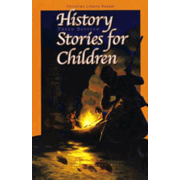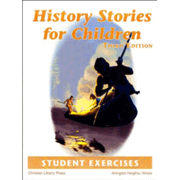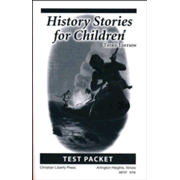History Stories for Children, now in its third edition, features more than sixty stories and poems that help bring history to life. Stories are each just a few pages long, perfect for the attention span of most children in the elementary grades. While the book is intended to serve as a reader, children should be able to read the stories independently by about fourth grade level.
Stories are grouped into five units. The first unit has key stories based on the Bible—stories about Joseph, David, the birth of Jesus, the Resurrection, and more. The second unit has stories from world history about people and events such as Alexander the Great, Martin Luther, Peter the Great, and the erection of the huge monument of Jesus and a cross that signified the peace between Argentina and Chile. The last three units consist of stories from the history of the United States within units titled "Coming to a New Land," "Life in America," and "Remembering America's Presidents."
Each story is followed by vocabulary words and their definitions, comprehension questions, and extension activities. You can use any of these that you find useful. The companion teacher's manual for History Stories for Children has a "Note to the Teacher" for many stories that adds some context or teaching suggestions. Sometimes the teacher's manual highlights one or more "Names to Remember" with brief information that you might pass on to students. Answers for comprehension questions are provided in the teacher's manual as well.
Extension activities at the end of each story or poem might be as simple as reading a passage from Scripture, playing or singing "A Mighty Fortress is Our God," or thinking of five things for which to be thankful. Other extension activities such as researching the game of horseshoes, planting a pineapple, or researching about the life of John Sevier and the State of Franklin will take more time and effort. A 17-page Student Exercises book has activity pages to be used with some of the extension activities. Some pages are for recording information, while others require filling in the blanks, solving puzzles, answering questions, and coloring with colored pencils. There is also a test packet for the book with six, multiple-choice tests.
You can use the book on its own or with your choice of the supplemental items. Personally, I would probably read the stories from the book aloud, and possibly use some of the comprehension questions. I might use the teacher's manual, especially the Note to the Teacher or Names to Remember. A number of extension activities can be used without the Student Exercises book, so I'd probably not bother with that extra item. I'd also skip the tests since the purpose of using stories is to create an interest in history that I don't want to dampen with a test.
Some stories tie in well with holidays, stories such as "Easter Lilies," "Washington's Birthday," "The First Fourth of July," and "How Thanksgiving Grew." Since you can use stories in whatever order you wish, you might plan ahead and use stories in correlation with calendar events as well as your core curriculum.
Because the stories are short and selective, this book will not serve as a core text, but it will make an excellent supplement to history studies for children in about second through fourth grade.












